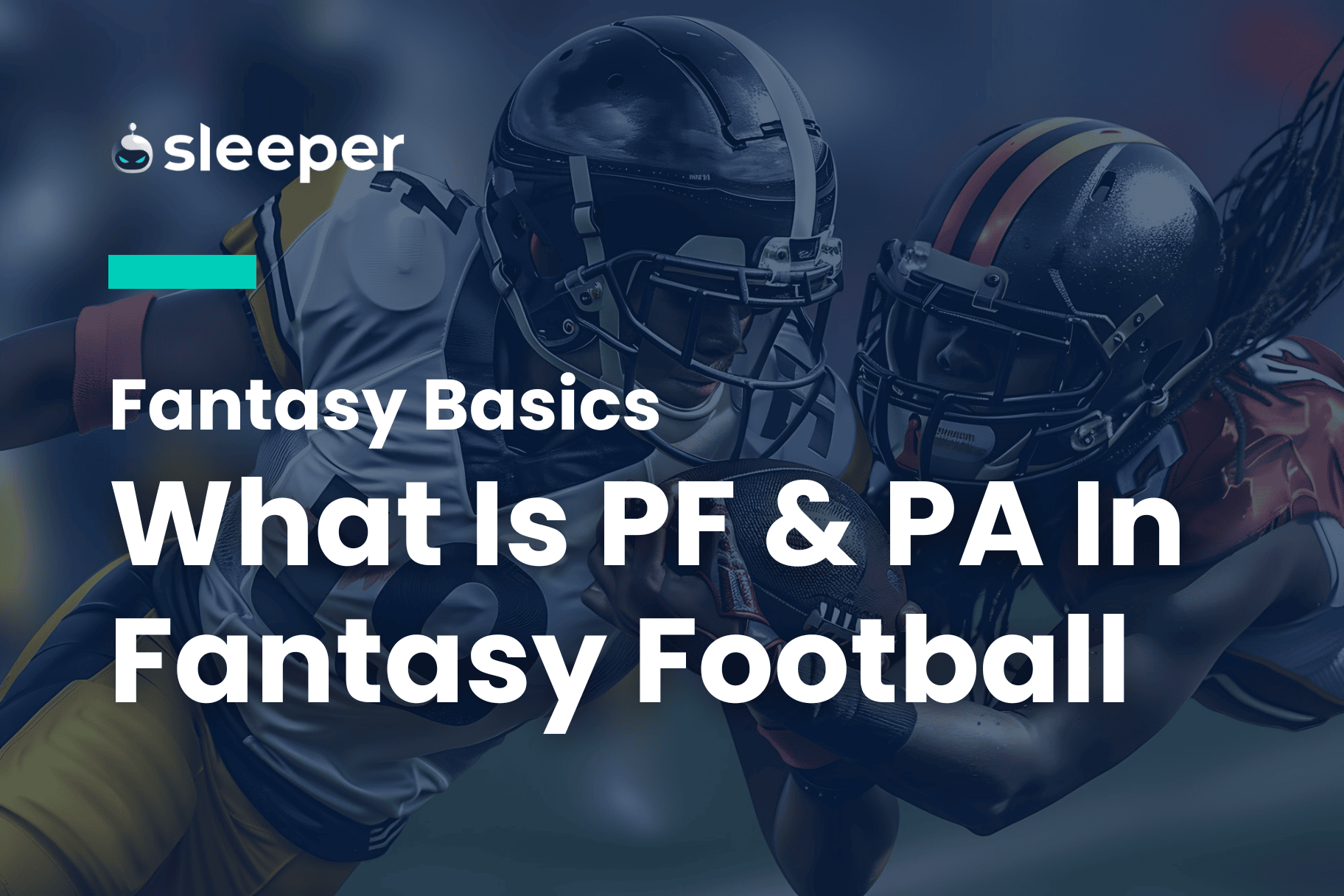What Do PF and PA Mean in Fantasy Football?

What Are PF And PA In Fantasy Football?
Like in all sports, wins and losses in fantasy football come down to one thing: the scoreboard. Points are king, no matter what a team’s roster looks like on paper, and at the end of every week, you’ve either scored more or less than your opponent. A game that can be very complicated at times always boils down to the simplest figure.
Cumulatively, though, those points — both the ones scored for your team and the ones scored against your team — have an impactful say on the bigger scoring picture. That brings us to two columns on your league’s standings dashboard to the right of W-L-T (yes, ties can technically happen) that are worth keeping a close eye on: PF and PA.
What Is PF In Fantasy Football?
PF stands for “points for,” which is the number of points your team scores. If, for example, you’ve put up 150 one week and 125 the next, then after two weeks your PF will read 275, and it will continue to accumulate as the season goes on.
PF is a significant metric for multiple reasons. Chief among them is that it’s a strong indicator of how consistent your team is (or isn’t) and whether you should stay the course or look to significantly upgrade your roster.
You might not win every week, but if your squad is consistently putting up big scores, then you can rest assured that the wins will follow — and if they don’t, there’s really not a whole lot more you could be doing. Some teams are just snakebitten when it comes to matchups like that.
Even if you’re dragged down to the middle of the pack with some bad luck, PF can still play a role in punching your playoff ticket as a primary tiebreaker (more on that below). To find the PF column in Sleeper, go to your league’s standings page and peer to the right of the team names.

What Is PA In Fantasy Football?
PA stands for “points against,” which means the amount of points your opponents have put up against you. That number is completely out of your control and often comes down to catching your opponents either at the right or (very) wrong time.
It’s not uncommon for a fantasy team to get remarkably lucky and wind up near the top of the standings despite not putting up massive numbers.
If a team’s opposition is weak on a regular basis, sometimes that low PA is all it takes to rack up the wins. Just know that it’s not a sustainable strategy, and it’s certainly not an indicator of a truly successful team.
Of course, if you’re on the right side of that equation, you’re likely not complaining about how you got in the playoffs, just as long as you’re in the mix.
The Importance of PF and PA in Fantasy Football
The most important stats in fantasy football standings are wins and losses, but PF and PA should not be overlooked. Here’s why:
PF and PA measure the quality of a fantasy team
Fantasy football can come down to matchup luck on any given week. But over the course of the whole season, things tend to unfold as they should, and if you’re regularly putting up a top-three score — or, conversely, a bottom-three score — then the standings should ultimately reflect that in the end.
PF and PA can determine tiebreakers
We’ve arrived at the most important element of PF and PA. If teams in the playoff hunt are tied and have the same win-loss record, the first tiebreaker in leagues is traditionally PF, and rightfully so. If your team has produced more fantasy points over the course of the season, it has earned the right to play for a championship over a lesser counterpart.
Head-to-head record is also widely used as the method of first tiebreaker, so make sure to check your league settings and regulations before banking on PF as your pathway through — not that you wouldn’t be trying to put up the biggest scores every week anyway.
Frequently Asked Questions
Do PF and PA matter in fantasy football?
Yes, they do. They’re the ultimate indicators of how your team is faring and can help paint a broader picture than just a great performance here or there. And if you’re an 8-6 team looking to eke into the playoffs, that PF column is likely going to make or break your chances as tiebreakers come into play.
What stats matter most in fantasy football?
Nothing matters more than wins and losses.<Al Davis voice> Just win, baby.
But to get there, piling up the touchdowns certainly helps (especially if you have a quarterback who rushes for them in abundance). And if you’re in a PPR (point per reception) league, then placing your focus on players who haul in catch after catch can help at the very least fortify your team’s weekly floor.
Why might PF and PA vary so much from league to league?
It all depends on scoring systems and roster sizes. A league, for instance, that only starts two WR and two RB and one flex and is not a PPR league is going to have significantly lower scores across the board than a league where you can start, say, three WR and two flexes and is a PPR league.
So when you’re going through your weekly review with a buddy who’s in a different league, and your 89 seems paltry compared to his or her 153, just consider there are many possible reasons why.
Start Piling Up Fantasy Points on Sleeper
In order to pad your own PF column, sign up for a season-long fantasy football league on Sleeper. You can join either via the website or by downloading the app, and you’ll be glad you did.
In addition to being free — and ad-free — the game has many unique features and benefits that enhance the experience compared to other popular fantasy platforms. It’ll provide you and your friends with an all-encompassing, and enjoyable season.